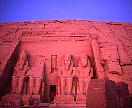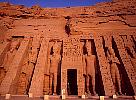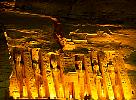 Travel
Photos Photo-Log
Photo-Tips
Photo-Links
Travel
Photos Photo-Log
Photo-Tips
Photo-Links
travel photo.net
- travel photography online:
copyright: Laurenz
Bobke
more
about this site
Photos of Abu Simbel
the temples that were rescued from the water
 |
 |
 |
 |
 |
 |
 |
 |
 |
 |
 |
 |
 |
 |
 |
 |
 |
 |
 |
 |
After the pyramids and the sphinx, Abu Simbel may be the most famous archaeological site in Egypt.
The awe-inspiring statues of Ramesses watching over lake Nasser and the temples cut out of the mountain are one of the most impressive places I've ever seen.
However, apart from this, Abu Simbel also is a symol of world-wide collaboration to preserve humankinds cultural heritage: the whole site was moved to a higher place to save it from the rising waters of the Nile after the construction of the Aswan high dam.
This did not only include the famous statues, but the whole interior (the great temple is more than 60 metres deep) had to be cut out of the surrounding mountain and moved to a safe level. An artificial mountain was constructed around it.
It is not easy to tell what is the greater achievement: the initial construction of the site with pre-iron age tools in the 13th century BC or the gigantic relocation project carried out in the 20th century.
More on this topic:
Unesco: Nubian Monuments
from Abu Simbel to Philae
Egyptian Monuments: Abu
Simbel
Egyptian Ministry of Tourism: Aswan
and Nubia, from Idfu to Abu Simbel
Travel Photo Net - copyright Laurenz Bobke
Africa | Egypt | Abu Simbel | Nile Cruise 1992 | Egypt 1992 | Luxor and Aswan 2004 |